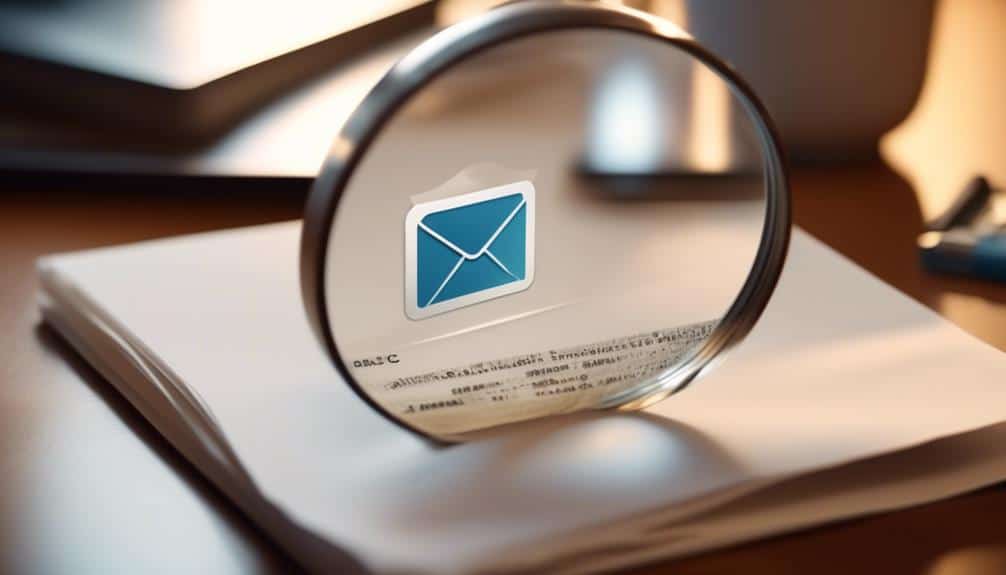Last Chance to Enhance Email Security With SPF and DKIM Authentication
Have you ever stopped to think about how vulnerable your email is to cyber threats? In today's digital age, where phishing attacks and email spoofing are on the rise, it's more crucial than ever to take steps to enhance your email security.
This is where SPF (Sender Policy Framework) and DKIM (DomainKeys Identified Mail) authentication come into play. These two authentication methods can provide an additional layer of protection to your email communications, ensuring that only legitimate senders can deliver emails on your behalf.
But why is it so important to implement SPF and DKIM authentication? Let's explore the answers together.
Key Takeaways
- SPF authentication prevents unauthorized senders from forging emails from your domain.
- DKIM authentication adds a digital signature to outgoing messages, ensuring their authenticity.
- Combining SPF and DKIM authentication reduces the likelihood of email spoofing and phishing attacks.
- Regularly reviewing and updating SPF records and rotating DKIM keys are essential for maintaining email security.
What Is SPF Authentication?

SPF authentication, also known as Sender Policy Framework authentication, is a crucial email security measure that helps prevent unauthorized senders from forging emails from your domain. It ensures that only authorized servers are allowed to send emails on behalf of your domain.
To implement SPF authentication, you need to create and manage SPF records for your domain. SPF authentication implementation involves adding a specific TXT record to your domain's DNS settings. This DNS record contains information about the authorized mail servers that are allowed to send emails for your domain.
When an email is received, the receiving server checks the SPF record to verify the authenticity of the sender. If the sending server isn't listed in the SPF record, the email may be marked as spam or rejected altogether.
Effective SPF record management is essential to maintain email security. As your organization's email infrastructure evolves, you must regularly review and update your SPF records to include all authorized mail servers. Failure to do so can result in legitimate emails being marked as spam or unauthorized emails bypassing spam filters.
How Does SPF Authentication Work?
To understand how SPF authentication works, it is important to grasp the underlying mechanisms behind this email security measure. SPF, which stands for Sender Policy Framework, is a protocol that helps prevent email spoofing by verifying the authenticity of the sender's domain. It works by checking the IP address of the email server sending the message against a list of authorized IP addresses published in the sender's DNS records.
When an email is received, the recipient's email server performs an SPF check by looking up the DNS records of the sender's domain. If the IP address of the originating server matches one of the authorized IP addresses listed in the DNS record, the email is considered valid. However, if the IP address does not match or is not listed at all, the email may be marked as suspicious or even rejected.
To illustrate the process, here is a table showing the steps involved in SPF authentication:
| Step | Description |
|---|---|
| 1 | The receiving server extracts the sender's domain from the email header. |
| 2 | The receiving server queries the DNS records of the sender's domain for the SPF record. |
| 3 | The SPF record contains a list of authorized IP addresses for the sender's domain. |
| 4 | The receiving server compares the IP address of the originating server with the authorized IP addresses. |
| 5 | If there is a match, the email is considered valid; otherwise, it may be marked as suspicious or rejected. |
While SPF authentication provides an additional layer of security, it has its limitations. The main limitation is that it only verifies the domain of the sender and not the actual identity of the sender. It cannot prevent email spoofing if the attacker uses a valid IP address listed in the SPF record. Additionally, SPF does not encrypt the email content, making it vulnerable to interception and tampering. To enhance email security further, it is recommended to combine SPF authentication with other measures such as DKIM and DMARC.
Why Is SPF Authentication Important for Email Security?

Email security is a crucial concern in today's digital landscape, and SPF authentication plays a vital role in ensuring the authenticity and integrity of email communications.
SPF, or Sender Policy Framework, is an email authentication protocol that helps prevent email spoofing. Email spoofing is a technique used by cybercriminals to send emails that appear to come from a trusted source, but in reality, they're not.
By implementing SPF authentication, organizations can specify which IP addresses are authorized to send emails on their behalf. This prevents attackers from using their domain name to send malicious emails, reducing the risk of phishing attacks.
Phishing attacks are a common type of cybercrime where attackers impersonate a legitimate entity to trick individuals into revealing sensitive information or performing malicious actions.
SPF authentication plays a crucial role in protecting against phishing attacks by enabling email receivers to verify the authenticity of the sender's domain. If the email fails SPF authentication, it's more likely to be flagged as suspicious or blocked, reducing the chances of users falling victim to phishing attempts.
What Is DKIM Authentication?
DKIM authentication is an email authentication method that adds a digital signature to outgoing messages. It helps verify the authenticity of the sender and ensures the integrity of the email content.
Here are three key advantages of using DKIM in email security:
- Prevents email spoofing: DKIM adds a digital signature to your outgoing emails, which can be verified by the recipient's email server. This prevents malicious actors from impersonating your domain and sending fraudulent emails on your behalf.
- Improves email deliverability: Many email providers use DKIM as a factor in determining whether an email should be delivered to the recipient's inbox or treated as spam. By setting up DKIM, you increase the chances of your legitimate emails reaching the intended recipients.
- Enhances brand reputation: DKIM helps build trust with your email recipients by ensuring that your emails are genuine and haven't been tampered with. This can help protect your brand reputation and strengthen customer relationships.
To set up DKIM for email authentication, you need to generate a DKIM key pair and add the public key to the DNS records of your domain. This allows the recipient's email server to verify the digital signature and authenticate your emails. Most email service providers offer step-by-step instructions on how to set up DKIM for your domain.
Take advantage of this powerful authentication method to enhance the security and trustworthiness of your email communications.
The Benefits of Implementing DKIM Authentication

Implementing DKIM authentication brings several significant benefits to your email security and deliverability. By using DKIM, you can ensure that your emails aren't tampered with during transit and that they're sent from legitimate sources. This helps to build trust with your recipients and reduces the risk of phishing attacks.
One major advantage of DKIM authentication is that it enables email recipients to verify the authenticity of your messages. By digitally signing your emails with a private key, you provide a way for the receiving mail server to verify that the message hasn't been modified in transit. This ensures that your recipients can trust the content of the email and that it originated from your organization.
Another benefit of DKIM authentication is improved deliverability. Many email service providers and spam filters use DKIM as a factor in determining whether an email is legitimate or spam. By implementing DKIM, you increase the chances of your emails reaching the recipient's inbox instead of being flagged as spam.
To ensure the best results, follow these best practices for implementing DKIM authentication:
- Generate a unique DKIM key pair for each domain or email sending source.
- Publish your DKIM public key in the DNS records of your domain.
- Regularly rotate your DKIM keys to enhance security.
- Monitor DKIM authentication reports to identify any issues and take corrective action if necessary.
Frequently Asked Questions
Are SPF and DKIM Authentication the Same Thing?
SPF and DKIM authentication are not the same thing. SPF checks if the sender's IP address is authorized to send email, while DKIM verifies the email's integrity and authenticity using digital signatures.
Can SPF and DKIM Authentication Prevent All Types of Email Security Threats?
SPF and DKIM authentication alone cannot prevent all types of email security threats. However, they play a crucial role in enhancing email security by verifying the authenticity of the sender, reducing the risk of phishing and spoofing attacks.
What Are Some Common Challenges or Issues That Organizations Face When Implementing SPF and DKIM Authentication?
Common implementation challenges include lack of understanding, misconfigurations, and compatibility issues. To overcome these, follow best practices such as educating staff, double-checking configurations, and testing compatibility with email servers and clients.
Is SPF or DKIM Authentication More Effective in Preventing Email Spoofing?
SPF and DKIM authentication are both effective in preventing email spoofing. Best practices for implementing them include configuring SPF records and signing messages with DKIM.
Are There Any Limitations or Drawbacks to Using SPF and DKIM Authentication for Email Security?
There are limitations to using SPF and DKIM authentication for email security. They do not prevent all forms of email spoofing and there are alternative methods like DMARC that can provide additional protection.
Conclusion
In conclusion, implementing SPF and DKIM authentication is crucial for enhancing email security.
SPF authentication verifies that the sender's IP address is authorized to send emails on behalf of a domain, reducing the risk of email spoofing.
DKIM authentication ensures the integrity and authenticity of emails by adding a digital signature.
By implementing these authentication methods, organizations can significantly reduce the chances of email-based attacks and protect their sensitive information.








